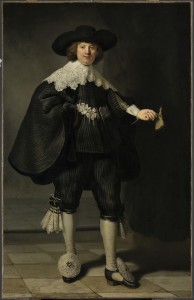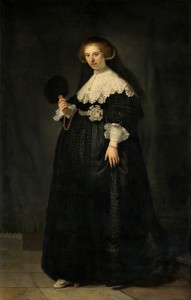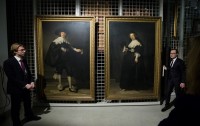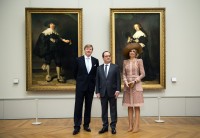 Marten Soolmans (1613-1641) was the son of a wealthy Calvinist sugar refiner who had fled Antwerp and the wars of religion for Amsterdam in 1585. In 1628, Marten, then just 15 years old, went to college in Leiden where he studied law and met a young painter named Rembrandt Van Rijn. Jurisprudence didn’t work out, so instead of a law career Marten acquired a wife in June of 1633. Oopjen Coppit (1611-1689) came from a very old, very rich Amsterdam family who had made their fortune in grain and gunpowder. Best of all, she brought a 35,000 guilder dowry with her to the marriage.
Marten Soolmans (1613-1641) was the son of a wealthy Calvinist sugar refiner who had fled Antwerp and the wars of religion for Amsterdam in 1585. In 1628, Marten, then just 15 years old, went to college in Leiden where he studied law and met a young painter named Rembrandt Van Rijn. Jurisprudence didn’t work out, so instead of a law career Marten acquired a wife in June of 1633. Oopjen Coppit (1611-1689) came from a very old, very rich Amsterdam family who had made their fortune in grain and gunpowder. Best of all, she brought a 35,000 guilder dowry with her to the marriage.
How better to spend some of that sweet dowry skrilla than on a pair of portraits painted by Rembrandt, at that time the most sought-after portraitist in the city. Marten and Oopjen had their portraits painted in 1634 when Rembrandt was 28 years old. No records of what they spent on the paintings have survived, but comparison with similar works suggests they paid at least 500 guilders per portrait.
 Decisively rejecting his Calvinist roots, Marten wears a satin-edged, starched black outfit with bows, elaborate lace collars, cuffs and garters and absolutely shamelessly huge rosettes on his shoes. He holds a glove in his hand as a symbol of fidelity to his bride. Oopjen dons a delicately patterned black silk and quilted satin gown with lace details matching his, although her shoe rosettes are comparatively petite. She is draped in exquisite jewels — pearl earrings, a pearl-festooned headdress, a four-strand necklace of pearls, a three-strand pearl bracelet, a gold rings on both hands plus a third hanging from her necklace. She holds an ostrich feather fan with a thick gold chain.
Decisively rejecting his Calvinist roots, Marten wears a satin-edged, starched black outfit with bows, elaborate lace collars, cuffs and garters and absolutely shamelessly huge rosettes on his shoes. He holds a glove in his hand as a symbol of fidelity to his bride. Oopjen dons a delicately patterned black silk and quilted satin gown with lace details matching his, although her shoe rosettes are comparatively petite. She is draped in exquisite jewels — pearl earrings, a pearl-festooned headdress, a four-strand necklace of pearls, a three-strand pearl bracelet, a gold rings on both hands plus a third hanging from her necklace. She holds an ostrich feather fan with a thick gold chain.
They were the first and last life-sized, full-length portraits Rembrandt ever made. Created in a style rarely seen in Holland at that time, their art historical significance has garnered them the moniker of “brother and sister of the Night Watch.” Before them, full-length, life-sized paintings of people standing up in their finest of finery were the province of royalty and aristocracy, and mostly in Flanders and down south. More than just images of moneyed people of the time, these proud, regal portraits of bourgeoisie capture the zeitgeist of the young Dutch Republic, then just 50 years old, and its new elite of merchants for whom bank accounts, not bloodlines, determined social hierarchy.
The two portraits were in private collections in the Netherlands for four centuries. After the death of collector from a long line of collectors Annewies van Winter, in 1877 her nine children sold the collection virtually in its entirety to Baron Gustave de Rothschild, scion of the French branch of the banking dynasty, for 1.5 million guilders, very much against the wishes of the Dutch government which tried its utmost to keep these unique masterpieces from leaving their homeland. They just couldn’t afford to compete with the Rothschilds. The Rembrandt Association was founded in 1883 in reaction to this great loss, its goal to raise money to prevent other treasures of Dutch artistic patrimony from suffering the same fate. The portraits of Marten and Oopjen remained behind closed doors in the Rothschild collection for the next 130 years plus, leaving only once for a temporary exhibitions at the Rijksmuseum and Rotterdam’s Boymans van Beuningen Museum in 1956.
In March of 2015, news broke that Baron Eric de Rothschild was planning on selling the portraits for a nosebleed asking price of €150 million ($168 million). He applied to France’s Ministry of Culture for an export license, and much to the general horror of the French press, it was granted. Why, outlets like La Tribune de l’Art asked, weren’t the portraits declared National Treasure which would block export and delay sale for at least 30 months to give France and its museums the chance to raise the money to buy them? There was no question they qualified for the National Heritage designation, but they weren’t even submitted to the Advisory Board of National Treasures. The Ministry and the Louvre responded that they knew very well that they wouldn’t have been able to raise that kind of money in 30 months or ever, so blocking export of paintings they couldn’t possibly keep would have been “a perversion of the device,” as Heritage Director Vincent Berjot put it.
The sounds of wailing and gnashing of French teeth were sweet music to Dutch ears. They quickly set to the task of raising an ungodly €160 million to acquire both portraits. By mid-September of 2015, a preliminary deal was signed. The government of the Netherlands would chip in half the sum, the Rijksmuseum the other half.
France wasn’t licked yet, though. Three days after the announcement of the preliminary agreement, the French Culture Ministry took a page out of King Solomon’s book and offered €80 million to buy one of the portraits. Culture Minister Fleur Pellerin claimed the offer was “part of joint efforts by France and the Netherlands” to split the baby between the Louvre and the Rijksmuseum, but Dutch officials were noncommittal at best. Besides, it was unclear whether Eric de Rothschild would even consider splitting up the works.
 On September 30th, 2015, France and the Netherlands published a joint press release announcing that they had indeed teamed up to buy the portraits. For months they’d been working on a deal wherein the countries would buy both portraits and share joint custody. They would pay €80 million apiece and while French acquisition law required that each party be the official owner of one painting, in fact the pair would never be separated and they would instead split their time between the two countries. The Netherlands got Marten Soolmans and France got Oopjen Coppit.
On September 30th, 2015, France and the Netherlands published a joint press release announcing that they had indeed teamed up to buy the portraits. For months they’d been working on a deal wherein the countries would buy both portraits and share joint custody. They would pay €80 million apiece and while French acquisition law required that each party be the official owner of one painting, in fact the pair would never be separated and they would instead split their time between the two countries. The Netherlands got Marten Soolmans and France got Oopjen Coppit.
 This was an unprecedented sale, the first joint acquisition by France and the Netherlands, the first artworks shared by the Louvre and the Rijksmuseum. The acquisition was concluded on February 1st, 2016, and since the portraits were already there, the Louvre was the first to put them on public display. Conservators did a basic cleaning and used “fake saliva” to restore some of their sheen before the portraits were unveiled on March 10th, 2016, in front of illustrious guests including Francois Hollande, President of France and the King Willem-Alexander and Queen Máxima of the Netherlands.
This was an unprecedented sale, the first joint acquisition by France and the Netherlands, the first artworks shared by the Louvre and the Rijksmuseum. The acquisition was concluded on February 1st, 2016, and since the portraits were already there, the Louvre was the first to put them on public display. Conservators did a basic cleaning and used “fake saliva” to restore some of their sheen before the portraits were unveiled on March 10th, 2016, in front of illustrious guests including Francois Hollande, President of France and the King Willem-Alexander and Queen Máxima of the Netherlands.
They will be on display at the Louvre for three months until June 13th, after which they move to Amsterdam where they will go on display at the Rijksmuseum next to the Night Watch for three months from July 2nd through October 2nd. They will then be removed for a thorough conservation. The conservation work will also be a joint effort, headed by Sébastien Allard, Director of the Department of Paintings at the Louvre, and Taco Dibbits, Director of Collections at the Rijksmuseum.
The conserved works will go back on display at the Rijksmuseum for three months before spending another three months in the Louvre. That will be the end of the short exhibitions. After the final three months in Paris, the portraits will return to Amsterdam for five years, then to Paris for five years. After that, each museum will have them for eight years at a time. The Louvre and Rijksmuseum have agreed that the paintings will always be exhibited together and will never be loaned to any other museums.